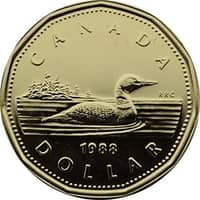
Have you ever wondered what Canadian money is made of?
If you are like most people, well you probably haven’t then! But if you are like me and you were in fact wondering this, well then you’ve come to the right place.
The purpose of this article is to give you, the readers, a chance to learn more about our great nation’s Canadian currency. Not only will this article look at the most recent composition of each Canadian coin, but it’ll give you the historical compositions of these denominations as well.
If you’re just here for a good time but not a long time, no worries, directly below here I’ve included a table for you as a quick overview of each denomination and it’s current composition.
What is Canadian Money Made Of?
| Canadian Money | Composition |
|---|---|
| Penny | 94% Steel, 1.5% Nickel, 4.5% Copper |
| Nickel | 94.5% Steel, 3.5% Copper, 2% Nickel |
| Dime | 92% Steel, 5.5% Nickel, 2.5% Copper |
| Quarter | 94% Steel, 3.8% Nickel, 2.2% Copper |
| Loonie | Steel, Brass Plating |
| Toonie | Steel, Nickel Plating, Aluminum Bronze, Brass Plating |
| Paper Money | Polymer |
The Penny, Nickel, Dime and Quarter are all made with Steel, Nickel and Copper. The Loonie is composed of Steel with Brass plating. The Toonie is composed of Steel with Nickel plating as the outer ring and Aluminum Bronze and Brass plating as the inner core. Finally, Canadian Paper notes are made with Polymer.
If you have a little more time and are interested in learning more about the historical composition of the Canadian currency, then I’d suggest reading through each section below to get a more comprehensive overview of how the makeup of Canadian money has changed over time.
Composition of the Penny

The current composition of the Canadian Penny is 94% Steel, 1.5% Nickel and 4.5% Copper.
| Current Composition of the Penny | First Introduced | Still Legal Tender? |
|---|---|---|
| 94% Steel, 1.5% Nickel, 4.5% Copper | 1858 | Yes* |

Related Article by the Financial Geek: 5 Places to Cash in Canadian Pennies
Historical Composition of the Penny
| Years | Composition |
|---|---|
| 2000–2012 * | 94% steel, 1.5% nickel, 4.5% copper plating |
| 1997–1999 | 98.4% zinc, 1.6% copper plating |
| 1982–1996 | 98% copper, 1.75% tin, 0.25% zinc |
| 1980–1981 | 98% copper, 1.75% tin, 0.25% zinc |
| 1978–1979 | 98% copper, 1.75% tin, 0.25% zinc |
| 1942–1977 | 98% copper, 0.5% tin, 1.5% zinc |
| 1920–1941 | 95.5% copper, 3% tin, 1.5% zinc |
| 1876–1920 | 95.5% copper, 3% tin, 1.5% zinc |
Composition of the Nickel

The current composition of the Canadian Nickel is 94.5% Steel, 3.5% Copper and 2% Nickel.
| Current Composition of the Nickel | First Introduced | Still Legal Tender? |
|---|---|---|
| 94.5% Steel, 3.5% Copper, 2% Nickel | 1858 | Yes |

Historical Composition of the Nickel
| Years | Composition |
|---|---|
| 2003–present | 94.5% steel, 3.5% copper, 2% nickel plating |
| 1999–2003 | 94.5% steel, 3.5% copper, 2% nickel plating |
| 1990–2001, 2006 | 75% copper, 25% nickel |
| 1982 – 1989 | 75% copper, 25% nickel |
| 1965–1981 | 99.9% nickel |
| 1953–1964 | Chrome plated steel (1953–1954) 99.9% nickel (1955–1964) |
| 1946–1952 | 99.9% nickel (1946–1951)Chrome plated steel (1951–1952) |
| 1942–1945 | 88% copper, 12% zinc (1942–1943)Chrome plated steel (1944–1945) |
| 1937–1942 | 99.9% nickel |
| 1922–1936 | 99.9% nickel |
| 1911–1921 | 92.5% silver, 7.5% copper (1911–1919)80% silver, 20% copper (1920–1921) |
| 1902–1910 | 92.5% silver, 7.5% copper |
| 1858–1901 | 92.5% silver, 7.5% copper |
Composition of the Dime

The current composition of the Canadian Dime is 92% Steel, 5.5% Nickel and 2.5% Copper.
| Current Composition of the Dime | First Introduced | Still Legal Tender? |
|---|---|---|
| 92% Steel, 5.5% Nickel, 2.5% Copper | 1858 | Yes |

Historical Composition of the Dime
| Years | Composition |
|---|---|
| 2000–present | 92.0% steel, 5.5% copper, 2.5% nickel plating |
| 1979–1999 | 99.9% nickel |
| 1969–1978 | 99.9% nickel |
| 1968 | 99.9% nickel (172.5M), 50% silver, 50% copper (70.4M) |
| 1967 | 50% silver, 50% copper (30.6M)80% silver, 20% copper (32.3M) |
| 1920–1966 | 80% silver, 20% copper |
| 1910–1919 | 92.5% silver, 7.5% copper |
| 1858–1910 | 92.5% silver, 7.5% copper |
Composition of the Quarter

The current composition of the Canadian Quarter is 94% Steel, 3.8% Nickel and 2.2% Copper.
| Current Composition of the Quarter | First Introduced | Still Legal Tender? |
|---|---|---|
| 94% Steel, 3.8% Nickel, 2.2% Copper | 1870 | Yes |

Historical Composition of the Quarter
| Years | Composition |
|---|---|
| 2000–present | 94.0% steel, 3.8% copper, 2.2% nickel plating |
| 1968–1999 | 99.9% nickel |
| 1967–1968 | 50% silver, 50% copper |
| 1953–1967 | 80% silver, 20% copper |
| 1920–1952 | 80% silver, 20% copper |
| 1910–1919 | 92.5% silver, 7.5% copper |
| 1908–1910 | 92.5% silver, 7.5% copper |
Composition of the Loonie

Canadian Loonies, first introduced to Canadians in 1987, are made of Steel with Brass plating.
| Current Composition of the Loonie | First Introduced | Still Legal Tender? |
|---|---|---|
| Steel, Brass Plating | 1987 | Yes |
Historical Composition of the Loonie
Prior to 2012, the Loonie was made with 91.5% Nickel and 8.5% Bronze plating.
Composition of the Toonie

The outer ring of the Canadian Toonie is composed of Steel with Nickel plating while the inner core is composed of Aluminum Bronze with Brass plating.
| Current Composition of the Toonie | First Introduced | Still Legal Tender? |
|---|---|---|
| Steel, Nickel Plating, Aluminum Bronze, Brass Plating | 1996 | Yes |
Historical Composition of the Toonie
Prior to 2012, the Toonie was made with 99% Nickel as the outer ring. The inner core was made with Aluminium Bronze composed of 92% Copper, 6% Aluminum and 2% Nickel.
Composition of Canadian Paper Money

The current composition of Canadian Paper money is 100% Polymer. According to the Bank of Canada, Polymer is a better, smoother and more durable material than cotton, which was the what Canadian paper notes were previously composed of.
| Current Composition of Canadian Paper Money | First Introduced | Still Legal Tender? |
|---|---|---|
| 100% Polymer | 1813-1815 | Yes |

Historical Composition of Canadian Paper Money
Prior to 2011, Canadian paper money was made with cotton.
Conclusion
And there you have it! The most recent and historical composition of Canadian money for each denomination.
Hopefully now you have no question about what money is made of and you’ve been able to find the answers to all your questions throughout this article.
I do plan to continually update this article so it can be used as a helpful resource for years to come, so if you know of any updates that have not yet been made within the article, feel free to contact us here so we can get things updated.
Don’t be shy! I don’t bite. The more up to date this article is the better, so trust me when I say I won’t be offended.
Geek, out.


![Corporate Jobs Meaning [What You Don’t Know]](https://thefinancialgeek.com/wp-content/uploads/2022/05/corporate-job-meaning-3.jpg)


![Is It Illegal to Draw On Money? [ACTUAL Answer]](https://thefinancialgeek.com/wp-content/uploads/2022/10/Featured-Image-41.jpg)
